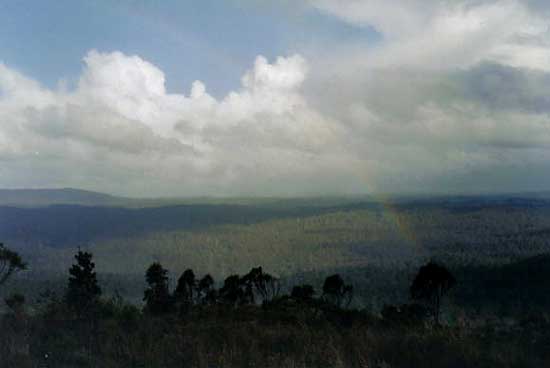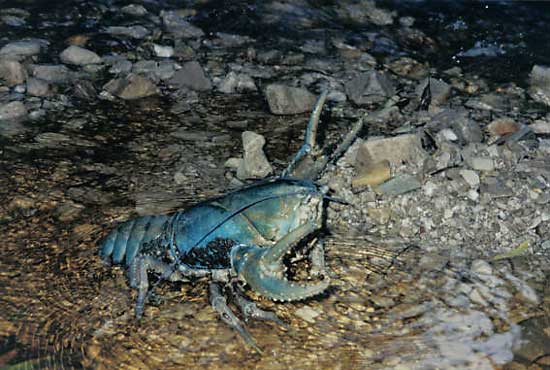As a little bit of background, our property
was purchased 13 years ago, for the purpose of living a healthy,
practical, mostly self sustaining lifestyle, incorporating growing
our own food, having access to our own water supply and to develop
a low impact, limited guest, eco tourism venture, focusing on
health, (as the area was renowned for its clean air and water),
and informative guided bushwalking tours, teaching people about
the environment. We do trout fishing guided tours, in the central
highlands, as well as an occasional local tour on our forests,
which have incorporated the giant fresh water lobster with the
inland fisheries and Todd Walsh. We are developing a small organic
miniature cattle farm and supplement this as painters, decorators
and landscapers.
In regards
to our Water Catchment: It is represented in the Governments
planning and management catchments document as part of catchment
number 28 Black creek – Detention River. We are located
on the 1:25000 Mawbanna 3646 Map as property no. 1742. (The
creek and road are the opposite way around)
Our property is located in the Shakespeare Hills which is
about 7km inland from the Bass highway at Rocky Cape. It
is predominatly a blackwood and manfern wet sclerophyll
rainforest, with some myrtle, sassafras, dogwood, leatherwood
and a variety of ground ferns etc. With dry schellphy forest
and button grass plains at higher elevations, including
some of the rare banksia serrata. It used to be a 90inch
rainfall area, though between climate change and Forestry’s
impact in destroying the significant water attracting systems
(ie the forest canopy, the creeks, the damp forest which
helps create that magical mist in the valleys) over such
a large area, the rainfall has declined in the last 2-3
years. |
 The Catchment due to be clearfelled
next year (2008)
The Catchment due to be clearfelled
next year (2008)
photo taken by Claire Gilmour |
The class 2 creek that runs through
our property is called Hook Creek. It is fed by literally hundreds
of smaller feeder streams, (class 3 and 4 ) from the surrounding
hills and valleys. It eventually runs into the Detention River.
The backbone water supply for much of the local community.
Hook Creek was once considered for daming by Port Latta for their
water supply as it’s a significant permanent running creek.
Luckily it wasn’t, as it is home to a significant number
of the very rare Blue Giant Fresh Water Lobster, the worlds largest
crustacean. With the help of Todd Walsh from the Lobster Recovery
Unit a small portion of state forest, though mainly button grass
plain on the surrounding hills, was conceded and protected for
the lobster habitat. It is also home to the healthy un-diseased
platypus, the lamp ray, blackfish, a variety of galaxia, and the
burrowing crayfish. The surrounding forest contains, healthy Tassie
devils, spotted quolls, wombats, bandicoots, the grey goswak,
the wedge tailed eagle, the azure kingfisher, the dusky, flame
and pink robins and the beautiful fire tail, amongst many other
species of wildlife.
There has been significant clearfelling and niten plantations
established to the west of us, starting within 200 metres of our
boundary. A number of class 4 streams used to run through this
area and eventually ran into the lower reaches of Hook Creek.
Most either don’t exist now or are so trashed little water
gets out of the plantations and ends up in Hook Creek. Considering
most of the plantations are between 2 and 7 years old, we believe
their water consumption has also contributed significantly to
the decline of runoff into the base of the catchment.
Last summer was very telling with Hook Creek drying up, (the first
time known to do so, according to the old timers in the area).
This started from the lower reaches (as feeder streams weren’t
contributing to it anymore) and progressing up stream to our property
which is the last private property on the creek. (No one actually
lives or irrigates off Hook creek below or above us, only after
it reaches Detention River) There was still water in tiny pools
starting about halfway up our property, but the water table had
dropped significantly. Besides running out of our own access to
water (we will top up our water tank from the creek when there
is little rain) for personal use, and as a water source in the
event of a bushfire, and veggie garden, we where fearful of what
had happened to the freshwater lobster. We didn’t find any
dead, and thought they must have burrowed into the water table.
On investigation we found a number had walked many many kilometers
up into the headwaters of the catchment and hidden in sink holes.
When we finally had some significant rain, and the creek started
running again, the lobsters could be seen every evening making
their way down the creek to their homes (they are very territorial).
Clearly the headwaters are very important to the freshwater lobster
in a drought or when the lower reaches have dried up. (From experts
in the field we have talked to, this phenomenon has not been witnessed
before, it is only out of our significant interest and living
in close proximity to these fabulous creatures that we where able
to witness this obviously life saving migration.)
| Recently,
without us being notified, Forestry put two roads, adding
up to 9 km into the upper reaches of Hook Creek, coming
of New Haven Road, which had previously only been accessible
by trial bike, horse or foot. After discovering these roads
and meeting with Forestry we have established they are intending
on clearfelling nearly the entire catchment and headwaters
of Hook Creek, totaling approx 6000 acres, (which includes
what has already been clearfelled and converted in the Crayfish
Creek catchment, with an adjoining 6000 acres to the west
towards Black Creek in the process of being cleared. Although
Forestry tried to appease us by saying, what hasn’t
been clearfelled and put into plantation will now be planted
to native species, the clearfelling and the subsequent massive
regrowth of such a vast area will, we believe, have a significant
impact on our water supply, especially over summer, and
the habitat of the freshwater lobster, the platypus and
the other native fish species. Todd Walsh recommended Hook
Creek a couple of years ago as warranting the highest possible
protection as a freshwater lobster habitat/breeding area.
Pockets of forest in this catchment had only ever been selectively
logged about 60 years ago. |
 Giant Blue Fresh Water Crayfish
in Hook Creek
Giant Blue Fresh Water Crayfish
in Hook Creek
photo taken by Claire Gilmour |
Already inappropriate forestry practices in road construction
have caused siltation in Hook and other creeks. The upper reaches
of Hook creek have infact been declared an undisturbed river by
the Australian Heritage Commission as it was so pristine. One
of the very few in the N/W. Forestry’s road has had significant
impact in the area, which we have declared is a breach to the
Forests Practices Board. We have requested impact and hydrology
information from Forestry Tas for a number of years on the creeks
and streams in the area, to no avail. We have successfully proven
one creek breach and had them fined, the FPA officer, disappeared
soon after. In later protecting some class 3 and 4s near our western
boundary, a Forest Practices Authority consultant, who has since
left, infact had to argue with the forestry planning officer that
these where considered class 3 and 4s. The forest planner wanted
them to be called drainage depressions so they could still be
logged. Successive FPA officers have been rather less instrumental
in ensuring the Code of Practice is adhered to!
Ultimately if forestry is allowed continued access to this area
and with their current practices, and based on our research, it
will significantly impact on Hook Creek, as it has on Crayfish
Creek and our ability to sustain ourselves and could well, especially
considering climate change, and the growth of the extensive plantations
in the area, affect Detention River and the sustainability and
hence livelihoods of farms and families who rely on this catchment.
Forestry is currently our, single biggest threat.
The Regional Forest Agreement and Forest Practices Code and the
Forest Practices Authority and Board are not, we believe, adequately,
ensuring a duty of care in such an important issue such as water
and water catchments and the profound and long term effects of
their destruction. We have made significant submissions to Forestry
and the Forest Practices Authority under the Good Neighbor Charter
and in regard to environmental protection of endangered species
and the personal risks their practices pose us.
Simply put, neither we nor the aquatic animal species can survive
here without our water supply.
|
|